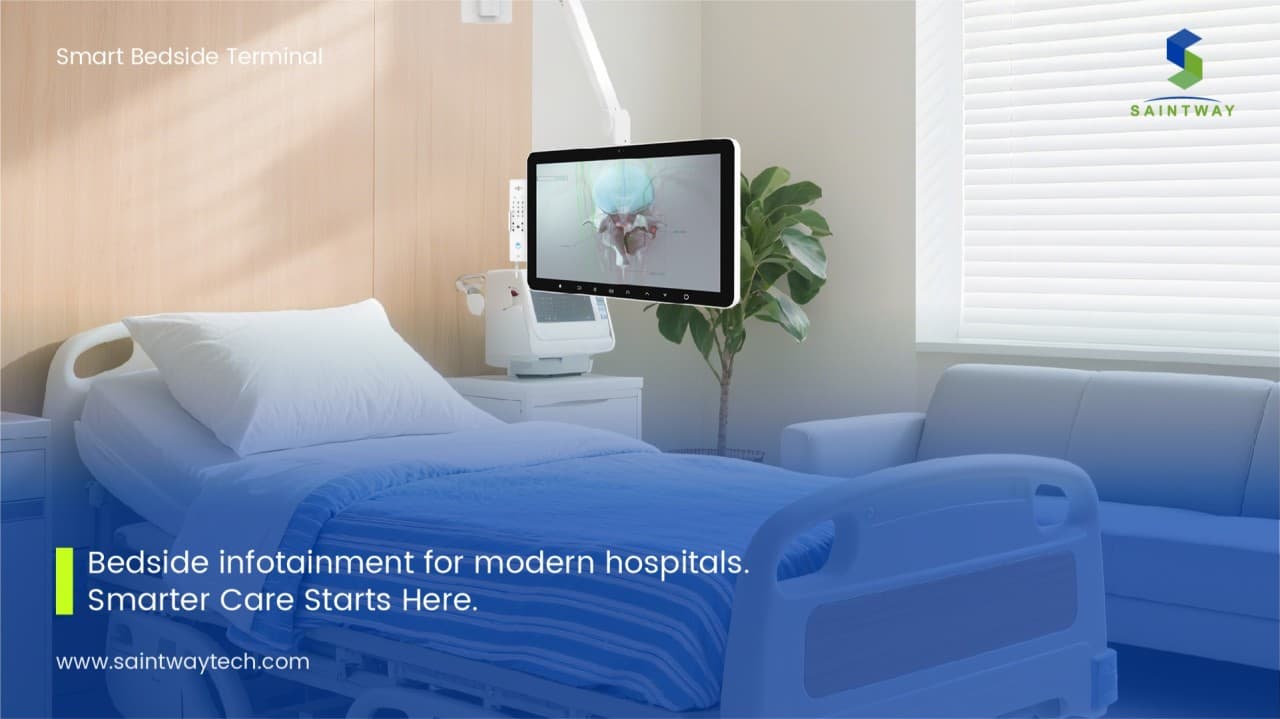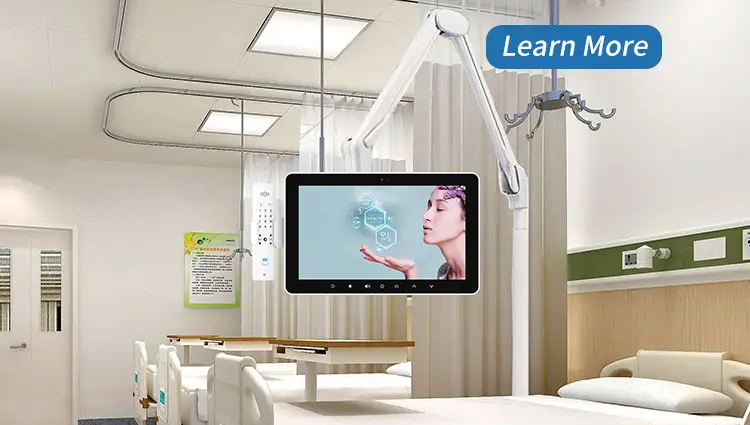Smart hospitals need more than cutting-edge software—they need a smarter way to deliver it.
That’s where bedside infotainment terminals come in.
No longer just hospital TVs, these intelligent devices have evolved into interactive hubs that support everything from EMR access to patient entertainment, from nurse call integration to real-time health education. They turn passive patients into active participants, while helping clinical staff work more efficiently and safely.

For hospitals and integrators building next-generation smart wards, bedside infotainment terminals aren’t optional—they’re essential.
If you’re planning a smart ward—or supplying software that powers one—this is the screen you don’t want to overlook.
What Makes a Bedside Infotainment Terminal Truly “Smart”?
Not all screens at the bedside qualify as “smart.” A true bedside infotainment terminal goes far beyond basic TV functionality—it’s an interactive medical-grade touchscreen that integrates with hospital information systems (HIS), electronic medical records (EMR), nurse call systems, and patient engagement platforms. It allows two-way communication, supports multi-language interfaces, displays personalized health data, and can be managed remotely by hospital IT. These capabilities turn it into an essential part of the hospital’s digital infrastructure, not just an entertainment device.
How Bedside Infotainment Terminals Support Patient-Centered Care in Modern Hospitals
Smart terminals empower patients by giving them real-time access to their treatment plans, meal schedules, medications, health education videos, and entertainment—all in one place. With options to adjust lighting, call a nurse, complete surveys, or watch family-friendly content, patients feel more in control and engaged in their recovery process. This aligns perfectly with today’s patient-centered care models, improving trust, communication, and overall satisfaction.
From Passive Screens to Active Tools: The Evolution of Bedside Infotainment Terminals
Traditional hospital TVs were passive—patients could only watch content, often without personalization. Today’s bedside infotainment terminals are active tools. They enable patients to interact with hospital systems, access personal health data, and communicate with care teams. This evolution reflects a larger shift in healthcare—where technology is not just for operations, but also for enhancing the patient experience directly.
The Clinical Benefits of Bedside Infotainment Terminals for Healthcare Providers
For healthcare staff, these terminals serve as time-saving assets. Nurses can receive pain score updates and non-urgent service requests (like for a blanket or water) through the system, reducing unnecessary interruptions. Doctors can use the terminal for bedside charting or to display diagnostic results during consultations. These devices enhance workflow efficiency, improve real-time communication, and reduce the administrative burden on clinical teams.
Why Bedside Infotainment Terminals Are Essential to Smart Ward Infrastructure
Smart wards rely on integrated systems that combine medical technology, patient data, communication, and automation. Bedside infotainment terminals are one of the few devices that connect directly with the patient while also linking back-end systems. They act as the human interface of a smart ward—turning digital infrastructure into something tangible and accessible for patients and providers. Without them, the smart ward is incomplete.
Real-Time Integration: How Smart Screens Connect with HIS, EMR, and Nurse Call Systems
The real power of bedside infotainment terminals lies in their ability to connect with hospital systems in real time. Through secure APIs and industry standards like HL7 and FHIR, they can pull patient records, show medication schedules, and sync with nurse call systems to streamline alerts and communication. For integrators and software vendors, this means a more responsive and intelligent care environment with fewer silos and better data flow.
Improving Patient Safety with Smart Bedside Infotainment Terminals
These terminals enhance patient safety by delivering personalized education content (like fall prevention videos), alerting staff to urgent service requests, and allowing patients to report symptoms or side effects early. With clear, multilingual interfaces and accessibility features, patients can better understand their care instructions—reducing risks caused by miscommunication or delayed response. Some models even support video calls for remote specialists, further improving safety through timely care.
Boosting HCAHPS and Patient Satisfaction with Interactive Bedside Terminals
Patient satisfaction metrics like HCAHPS are directly influenced by communication, comfort, and perceived control—exactly what infotainment terminals improve. When patients can control their environment, access information when they want it, and feel heard via feedback tools or service request systems, they report a better experience. This translates to stronger reputations for hospitals and improved funding or accreditation opportunities.
Choosing the Right Bedside Infotainment Terminal: A Buyer’s Guide for Smart Hospitals
Not all terminals are created equal. When selecting a bedside infotainment terminal, hospitals and integrators should look for:
- Screen size (10″–21″ with high brightness and anti-glare)
- POE (Power over Ethernet) support
- Antimicrobial surfaces
- Integration capability with HIS/EMR/Nurse Call
- Remote management and OTA updates A poor hardware choice can limit integration, frustrate patients, and drive up long-term costs.What Smart Wards Are Doing Differently with Bedside Infotainment Terminals in 2025
What Smart Wards Are Doing Differently with Bedside Infotainment Terminals in 2025
Leading hospitals are already showing how powerful these terminals can be. They’re integrating them into patient education strategies, virtual rounding tools, and telehealth services. Some are using them for real-time satisfaction tracking, multilingual patient engagement, or even in-room e-checkouts. The future is here—and it’s bedside. These hospitals aren’t just using screens—they’re building experiences around them.

